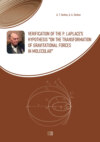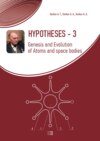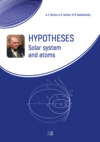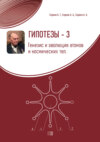Read the book: «Verification of M.Faraday's hypothesis on the gravitational power lines», page 2
3. The gravitational field of a stationary body
Cosmic body creates around itself a force field – the gravitational field. The main characteristic is its gravitational strength tension at any point. It characterizes the force which acts on a point located in this different body. The tension is given by:
g = F / m, (2)
where g – the field strength (tension), F – gravitational force, m – mass of the test body made to the field.
The gravitational field can be described analytically by calculating it's intensity for each point of the field or graphically, causing tension in the plot line or field lines. An example of a graphic image of the gravitational field is shown in Figure 2. Power lines or tension lines (1) begin at cosmic body (2) and extend into the surrounding space according to the formula (2) to infinity. When interacted many bodies the line tension can take a curved shape and then on the graph the field strength can be characterized by density of the location of power lines.

Fig.2. Schematic representation of the gravitational field: 1 – line tension (power line), 2 – cosmic body.
In accordance with the above concept to consider the surrounding physical environment induced in her gravitational field as elastic-viscous body can be assumed that this body has the ability to tensile strain and shear. The greatest interest is the shear deformation, which during rotation of the body can cause a concentric orientation of the force lines and thus reduce the resistance of the field orbital motion space bodies.
4. The gravitational field of a rotating body
The interaction of a rotating body with elastic-viscous gravitational field, like other elastic-viscous fluids (liquids, gases) can be considered within the theory of dynamic boundary layers. However, with a persistent finding in the literature [4], it is almost not possible to find data on formation the boundary layers the rotating bodies.
The closest well-studied case can be considered a tear flow when the fluid flow separates from the surface of the curved shape. At the front of the body curved shape (Fig. 3) the flow velocity in the boundary layer decreases from the value v0 on the outer edge of the layer and to v = 0 on the body surface, At the point s there is separation of a laminar boundary layer, and turbulization of the flow.

Fig. 3. The scheme of formation of separated flow around the flow body with a curved generatrix: v0 is the flow velocity, s – point margin, δ – thickness of the boundary layer.
Given that according to the accepted concept to consider the gravitational field as a viscous-elastic medium, we can assume that during the rotation of a celestial body around it will produce dynamic laminar layer δ, the thickness of which will depend on the mass and speed of its rotation and to meet space scale (tens to hundreds of thousands of miles).
Figure 4 provides a diagram of the dynamic boundary layer (2) of the gravitational field on the surface of a rotating spherical celestial body (1). The body rotates at a linear velocity v0. Due to the viscosity of the environment (physical vacuum) formed in the boundary layer, the velocity gradient. On the body surface at point s, the velocity of the particles of the physical environment is equal to the linear velocity of the body vo. As the distance from the surface it drops to zero at the surface boundary layer.

Fig.4. The formation of a boundary layer δ around the rotating sphere: 1 – rotating sphere, 2 – laminar boundary layer, 3 – turbulent boundary layer, vo – linear speed on the surface of a sphere, s – point separation, fg is the gravitational force, fc is the centrifugal force,
At point s on the boundary layer, there are several forces that seek to tear it from the body surface. Most of this is centrifugal force fc due to rotation of the body. Another force that is oriented on the boundary layer separation is a normal component of the force is the viscous resistance of the physical environment fv. Has a certain value of the normal component of the inertial force fi, although in the modern sense of the properties of the physical vacuum is hard to speak about its mass (dark matter!). These forces are balanced by gravitational force fg, so that the formation of a boundary layer around the rotating spheres equality:
fg = fc + fv + fi, (3)
For a laminar boundary layer lies a turbulent layer δt (3). However, the turbulent layer, apparently, can occur directly on the surface of the body, if the three components of the breakout forces in equation (3) will be greater than the gravitational force.
Of great importance is the velocity gradient in the boundary layer. Thanks to the difference of the layer velocity will be concentric (tangential) orientation of the force lines that will lead to such changes in the properties of the gravitational field in which the orbital moving body will not cross the power lines and expend energy on their intersection. Due to the concentric orientation of the power lines appear energetically favorable orbit on which the appeal cosmic bodies will be without energy consumption.
Conclusions
1. The considering the characteristics of the gravitational field of stationary and rotating celestial bodies proceeded from the hypothesis M Faraday that "the Sun generates a field around itself, and the planets and other celestial bodies feel the influence of the field and behave accordingly."
2. The gravitational field of a celestial body is implemented in the physical environment (ether, vacuum, dark matter) and is considered as a viscous-elastic body, which can be characterized by several properties: module tension, viscosity, anisotropic structure, the ability to shear deformation.
3. Shear strain field during the rotation of the body takes in to account the regularities of the dynamics of boundary layers formation, in its particular case – separated flow. Given the balance of forces, in which a separated flow is realized with the formation of a boundary layer on the surface of the rotation body.
4. The velocity gradient in the boundary layer leads to a concentric orientation of the power lines of the gravitational field. The area with the maximum orientation of the power lines characterized by minimal resistance to movement of the orbiting body and is treated as an allowed orbit.
Literature
1. Force field. Published 21.12.2012 | By Astronomer
2. www.sciteclibrary.ru/rus/catalog/pages/4903.html
3. A.Serkov, Hypotheses, Moscow, Ed.LLC SIC "Uglekhimvolokno", 1998, S. 73.
4. www.aerodriving.ru
Chapter 2. Gravimagnetic braking of celestial bodies
Summary
Expressed and justified the assumption that the braking satellites of the moon due to gravimagnetic forces arising at the intersection of the satellites of power lines (line tension) of the gravitational field. To calculate the forces used an equation similar electrodynamics equation of the Lorentz force. The estimated braking time for "the lunar Prospector", "Smart-1" and "Kaguya" is the same as the actual precision of ± 14 %. The scheme occurrence of gravimagnetic forces is proposed, according to which the magnitude of the force depends on Sinα, where α is the angle at which the satellite crosses the line gravimagnetic tension. For non-rotating body as Moon, this angle is equal to 90*0 and thegravimagnetic braking force has a maximum value. In the case of rotating bodies, such as Earth, the intersection of the gravimagnetic tension lines, apparently, is at a sharper angle and the braking force is substantially less (the effect of "Pioneers" and the satellites "Lageos").
Suggested that the rotating of the central body causes the surrounding gravitational field with a periodic alternation of layers with a predominant radial and concentric orientation of the force lines of the gravitational field, which leads to a different intensity of the forces and gravimagnetic braking along the radius and emergence (allowed, elite) and unstable orbits (unresolved) orbits with high speed braking.
The equation is proposed which determines the distance to stable orbits. In the equation a constant C = 2,48.10*8 cm/s is close in magnitude to the gravidynamic constant of 2.16.10*8 cm/s, which is included in the equation similar to the equation of the Lorentz force, which was calculated power gravimagnetic braking.
1. Introduction
"Does the gravitational field of the similarity with magnetic? Turn any electrical charge, and you get a magnetic field. Turn any mass, and, according to Einstein, you have to detect very weak effect, something similar to magnetism" is so popular NASA has justified the need to launch several satellites to detect effects of gravimagnetism. We are talking about the launch of the satellite gravity probe B (Gravity Probe B), in which gravimagnetic effect is expected to detect at the exact precession of gyroscopes mounted on the satellite [1]. In another experiment (frame-dragging), associated with the launch of two geodynamic satellites Lageos-1 and Lageos-2 (LAGEOS and LAGEOS II), it was shown [2] that the precession was only 20 % of the level predicted by the theory.
Gravimagnetic effect can be detected not only by the precession of gyroscopes or "rotating frame", but also for deceleration or acceleration of the satellite depending on the direction of the force lines of the gravitational field and the direction of motion of gravitating bodies. Seems anomalies in the movement of the "Pioneers" in their acceleration or deceleration depending on the position in respect of gravitating bodies are also a consequence of gravimagnetic interaction [3].
In this work the effect of gravimagnetism is considered on the example of anomalously high speed braking satellites of the moon and the laws of planetary and satellite distances, which, as it turns out, is also related to gravimagnetism through the rotation parameters central bodies.
2. Gravimagnetic power
Continuing the analogy with electrodynamics, braking force when interacting gravitating bodies can be expressed by the formula similar to the known electrodynamics equation of the Lorentz force:
fgm = (v/C)2(GMm/r2)Sin α, (1)
Where f is the force gravimagnetic interaction of bodies with masses M and m, remote distance r squared and moving relative to each other with velocity v in the direction at an angle α to the intensity vector gravimagnetic field, G is a gravitational constant and C is a constant with the dimension of velocity cm/sec. This will Illustrate scheme, see 1 a and b.

Fig.1. Scheme of occurrence gravimagnetic forces: (a) a body with mass m, moving with velocity v in a gravitational field G, generates gravimagnetic field intensity H and the force f; (b) gravimagnetic force f (perpendicular to the plane of the drawing up) has a maximum value when α2 = 90° and sinα = 1, the reduction of the angle α leads to a decrease in f, if α = 0 the force f is also zero.
Body m moves in a gravitational field G with velocity v at right angles to the power lines, Fig. 1a. The movement body m causes gravimagnetic field intensity H, the vector of which is directed normal to the vector of gravitational field strength G and the direction of body motion v. In this case, the moving body m will act normal to the direction of motion and the vector gravimagnetic tension braking force f. The magnitude of this force depends on the angle between the motion direction and the intensity vector gravimagnetic field H, see Fig.1 b. At α = 90° Sinα = 1, and the force f has a maximum value. When decreasing α below 90° decreases f and when α = 0 the braking gravimagnetic force disappears. The body moves in gravimagnetic field without resistance and energy consumption.
To confirm advanced assumptions gravimagnetic braking bodies consider for example, at motion of satellites of the moon.
3. Gravimagnetic braking satellites of the moon
Starting with the first orbital flight of a satellite of the moon "Luna-10" [4, 5], which was launched on 3 April 1966, it became clear that the lunar satellites have abnormally high acceleration and the duration of their existence on the orbit is limited. Of all possible causes inhibition: perturbations due to the influence of the Sun and the Earth, the uneven distribution of mass, the presence of the moon, though very thin atmosphere, the impact of the solar wind – focused [6] non spherical shape of the moon. It was shown that perturbations caused by the non centric gravitational field of the Moon is 5-6 times larger than the perturbations due to the Earth's gravitation, and the latter exceeded the solar 180 times.
The main reason for the occurrence of braking forces of the moon satellites may not be the uneven mass distribution, in particular the no spherical character of the Moon. Any algorithm for calculating the impact of uneven distribution of mass, the result depends on the mass of the satellite. The larger the mass, there is stronger interaction and the less the lifetime of satellites in orbit.
However, the available data do not support this conclusion. For example, the satellite Kaguya" had a lot 2371 kg, and the duration of his stay in orbit amounted to 539 days, while the lunar Prospector", having mass 158 kg, ceased to exist after 182 days. As will be shown below, the deceleration time of the Moon satellites does not depend on their mass.
The scheme gravimagnetic braking of the moon satellites is shown in Fig. 2. A satellite with mass m moves with velocity v, traversing radially spaced the force lines of the gravitational field G. The direction of the intensity vector occurring due to the motion of the satellite is perpendicular to the plane of the figure upwards. A satellite is braking by force f that causes the decrease of the orbital distances. By analogy with electrodynamics braking is accompanied by the gravitational radiation at a rate equal to the constant C in equation (1).

Fig. 2. Scheme gravimagnetic braking the lunar satellite: a satellite with mass m moves with velocity v, traversing radially spaced force lines G of the Moon gravitational field (M); the direction of the intensity vector gravimagnetic field arising due to the motion of the satellite perpendicular to the plane of the drawing up; a satellite is retarding force f that causes the decrease of the orbital distance.
Braking force satellite f in addition to equation 1 can be expressed by the equation of momentum:
ft = m(v2 – v1), (2)
where m is the satellite mass, t is the time of braking, v1 and v2 are the velocities before and after braking. Combining equations (1) and (2) obtain a convenient expression for calculating the time of flight of the satellite:
t = (C/GM)2r3(v2 – v1), (3)
where t is the time of flight, C is a constant having the dimension of velocity cm/s, G is the gravitational constant 6,67.10-8 cm3/G2, M is the mass of the Moon 0,735.1026 g, r – average orbital distance (the semi major axis) at the beginning of the flight, v1 and v2 are the initial and final orbital velocity, calculated at an average orbital distance.
Returning to the question of the effect of aspheric of the moon on the braking of its satellites, note that in equation (3) expressing the time of flight the satellites is no their mass. This confirms the previously made conclusion about the independence of the flight time from the mass of the satellite.
The constant C in equations (1) and (2) if you follow the accepted analogy with electrodynamics, by definition, is the speed of gravitational radiation. Thus, equation (3) can be used to calculate dynamic gravitational constant, i.e. the velocity of propagation of gravitational waves.
The constancy of the constants when calculating for different satellites will confirm the correctness of the methodological approach. Below is data for the calculation of the constants for the evolution of the orbits of the fife satellites of the Moon, including the Soviet satellite Luna-10", American satellite "the lunar Prospector", a satellite of the European space Agency's Smart-1", as well as Japanese and Indian satellites "Kaguya" and "chandrayan-1.
Consider the launch and flight of Sputnik "Luna-10". First, "Luna-10" was put into orbit an artificial satellite of the Earth. Then, using the upper stage, the speed of the station was reduced to 10.9 km/s. At that speed, the duration of the flight to the Moon was slightly less than three and a half days.
Then was the correction of the trajectory, after which the station entered the sphere of gravitational influence of the Moon.
At the final stage of the flight (800 km from the Moon) station has been previously appropriately focused and calculated point remote from the surface of the moon for 1000 km was included braking engine unit and the speed was reduced from 2.1 to 1.25 km/s, which provided the transfer station under the action of the attraction of the Moon with the span of the trajectory on selenocentric orbit with the following parameters: the greatest distance from the surface of the Moon – 1017 km (apocenter 2,755.108 cm); smallest – 350 km (pericenter putting on 2,088.108 cm); the average distance (the semimajor axis) – 2,422.108 cm; average orbital speed – 1,4229.105 cm/s; period of revolution around the moon – 2 hours 58 minutes 15 seconds; the angle of inclination of the satellite's orbit to the plane of the lunar equator – 71° 54. The mass of the spacecraft after separation from the booster was 1582 kg, the mass of the lunar satellite 240 kg
Artificial satellite of the Moon "Luna-10" there were active 56 days (0,0484.108 (s) having 460 revolutions around the Moon. After the batteries have been depleted, the relationship was terminated on May 30, 1966. Orbit at this time had parameters: minimum destruction of 378 km (pericenter 2,116.108 cm), the greatest destruction of 985 km (apocenter 2,723.108 cm and an inclination of 72.2 degrees. The average distance (the semi major axis) – 2,420.108 cm. Average orbital speed – 1,4235.105 cm/s.
Substituting the given data into the formula (3), find the value of the constant C = 3,694.108 cm/s Calculated data are presented in Table 1. Perform similar calculations for other travelers of the Moon.
Table 1. The calculation of the duration of the flight, the constants C and braking force to the satellites of the Moon.

Accordingly, the orbital velocity at the beginning of the highlighted portion of the orbit v1 = 1,665.105 cm/s and at the moment of falling v2 = 1,680.105 cm/s Substituting the above values in the formula 3, we get the value of the constants C = 2,25.108 cm/s, that is close in order of magnitude to the value of the constants calculated for the satellite "Luna-10. The satellite of the moon, Smart-1 (Smart-1: the acronym for Small Mission for Advanced Research in Technology) launched by the European space Agency September 30, 2003 [8]. Initially, it was launched into an elliptical low earth orbit typical of telecommunication satellites with the help of the rocket Ariane-5. Then the output on the lunar orbit was carried out using a low-power (thrust force of 0.07 N) ion propulsion and lasted 16 months.
After moving into the area of the gravity of the Moon and the braking propulsion system on November 11, 2004 "Smart-1" has been translated into lunar orbit. The mass of the satellite 367 kg After number of maneuvers in the period from 28 February to July 18, 2005 the satellite was in free flight, that is, without the inclusion of the propulsion system. The orbital parameters at the beginning of this period: apocenter 4,6182.108 cm and the pericenter 2,2087.108 cm. The average distance (the semi major axis) 3,4134.108 cm After a flight during 0,121.108s apocenter decreased to 4,4957.108 cm, and the pericenter increased to 2,3493.108 cm. The average distance decreased to 3,4025.108 cm.
Orbital speed at the beginning and end of the free flight accordingly was 1,1984.105 and 1,2004.108 cm/s Substituting the obtained values of the average distance in the beginning of the period of free flight and orbital velocity at the beginning and end of the flight in the formula 1, we get the value of the constant C = 1,91.108 cm/s, which is close enough to the values previously given for satellites "Luna-10" (3,69.108 cm/s) and the lunar Prospector" (2,25.108 cm/s).
Japanese satellite of the Moon "Kaguya" was launched on 14 September 2007 with the Japanese Baikonur Tanegasima using booster h-2A (H-2A) [9]. The mass of the satellite 3000 kg. To the orbit of the moon it was only appear on 4 October 2007. After separation of the two auxiliary satellites, test equipment and instruments basic core ("Main orbiter") mass 2 27 1kg December 2007 began their regular observations on polar circular orbit with altitude of 100 km (the distance from the center of 1,838.108 cm, orbital speed 1,6332.105 cm/s).
The time of the flight without the inclusion of the propulsion system lasted until June 11, 2009, that is 0,466.108 s. At the point of activation of the brake motor installation altitude was 27.8 km (the distance from the center of 1,776.108 cm), which corresponds to the orbital velocity 1,6661.105 m/s. Then, after 6 minutes the connection with the satellite was lost. Substituting the values of change of orbital parameters in the formula 1, we get the value of the constant C = 2,34.108 cm/s, very close to the values previously calculated for other satellites.
Indian space research organization (ISRO,) reported [10] about the launch of 22 October 2008 on a circumlunar orbit of his device
"Chandrayan-1 using developed in Indian rocket PSLV–XL (PSLV – Polar Satellite Launch Vehicle from Baikonur Satish Dhawan. Starting weight station was 1380 kg, weight station in lunar orbit – 523 kg.
After a series of maneuvers November 4, the station went on the flight path to the Moon and on 8 November reached the environs of the Moon, where at a distance of 500 km from the surface was included brake motor, resulting in the station moved to a transitional circumlunar orbit resettlement 504 km, aposelene 7502 km and an orbital period of 11 hours. Then on 9 November, after adjustment of the pericenter of the orbit was lowered to 200 km. On November 13, the station was transferred to the circular working circumlunar orbit with altitude of 100 km (1,838.108 cm from the center of the Moon), a cycle time of 120 min, the orbital speed 1,6332.105 cm/s.
On August 29, 2009 ISRO announced that radio contact with the satellite was lost. By the time of the loss of communication with the satellite, it stayed in orbit 312 days (0,27.108 (s) and managed to make a 3400 revolutions around the Moon.
Indian space research organization claims that her device will be in lunar orbit for another 1000 days. The lack of data on the orbital parameters after braking satellite Chandrayaan-1 does not allow the calculation of the constant C. However, determining the average value for other satellites, using equation (3) to confirm or refine the prediction of the lifetime of the satellite "Chandrayan-1.
The average value of the constant C it is advisable to calculate on three.satellites: "the lunar Prospector", "Smart-1" and "Kaguya". It is of 2.16.108 cm/s. The large deviation of the satellite is "the Moon-10" – 3,690.108 cm/s is associated with significant orbital eccentricity at which the intersection of the gravity-magnetic power lines occurs at small angles and braking force in accordance with equation (1) is small. Therefore, the estimated flight time is significantly less than the actual, since the calculation was made according to the formula (3), in which the angle α was not taken into account.
With regard to satellite "Chandrayan-1, the calculation showed that the total time spent in orbit until the fall on the surface of the Moon is 644 days including 332 days after loss of communication with the satellite.
The deviations of the estimated time from the actual for other satellites are given in table 1. In the case of a satellite, the lunar Prospector" observed the coincidence of two values: 0.157.108 and 0,153.108 C. For "Smart-1" rated value is 12.5 % higher than the actual, for the "Kaguya" 15 % below the actual time of flight of the satellite. This coincidence of the calculated and observational data confirms the correctness of the made assumptions about the braking satellites of the moon due to gravimagnetic forces.
The free excerpt has ended.


















